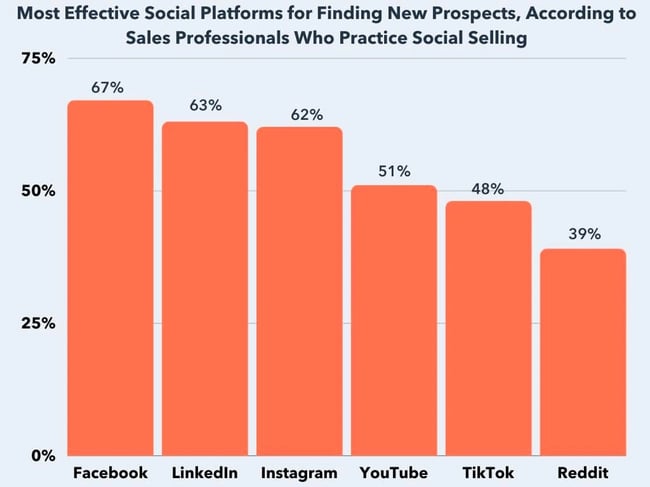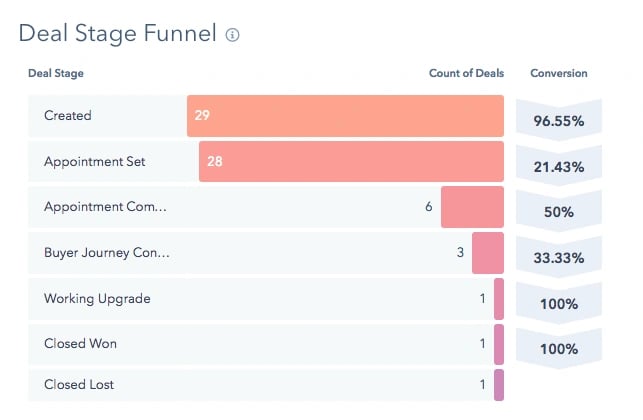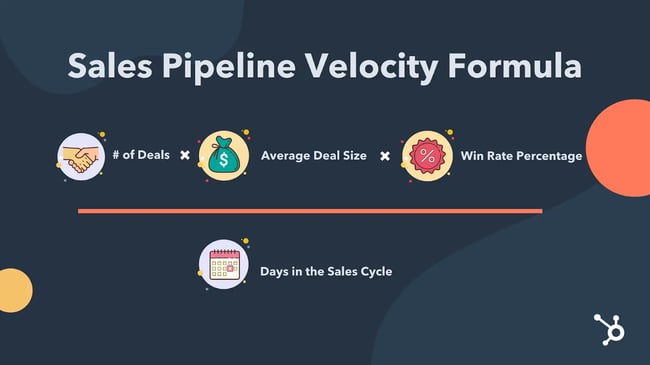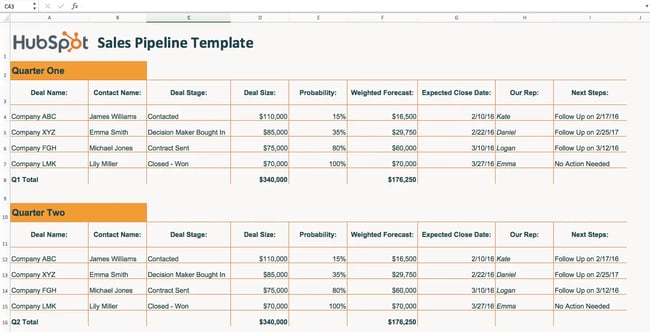Dive into building and managing a sales pipeline in HubSpot to exceed your revenue goals.
How to Build a Sales Pipeline
How long does it take to build and develop a sales pipeline? The answer depends on your product, base, sales team, and marketing resources.
Here are the basic steps to building a sales pipeline.
1. Define the stages of your sales pipeline.
While the quickest way to define your sales pipeline stages might be copying a template, developing your own is worth the time and effort.
After all, the pipeline stages must match your prospect's buying journey to help you track progress and predict revenue effectively. However, customers undergo a typical process:
- Awareness. The buyer realizes they have a pain point or opportunity.
- Consideration. The buyer defines their paint point, develops evaluation criteria, and researches potential approaches.
- Decision. The buyer has finalized their strategy and compares vendors/specific solutions.
With that in mind, your sales pipeline stages might be:
- Connect. The buyer engages with your company through an email from a salesperson, a webinar, or a piece of content.
- Appointment set. The buyer agrees to a meeting to learn more about how you can help them.
- Appointment completed. They attended the meeting, and you confirmed the next steps.
- Solution-proposed. The buyer wants to use your product to solve their pain point or capitalize on their opportunity.
- Proposal sent. The buyer reviews your proposal or contract.
Note that this is a standard explanation; the more complex your product, the longer your sales cycle will take and the more sales pipeline stages there may be.
2. Identify how many opportunities continue through each stage.
You should know how long prospects spend in each stage — both across the board and for closed/won deals. For example, the average prospect may spend two weeks in the demo stage, while those who eventually buy spend three weeks.
You should also know the percentage of opportunities that advance to the next stage.
And it's critical to establish yield probability (or conversion rate) per stage. Perhaps prospects are 75% likely to buy in the demo stage and 90% likely to buy in the negotiation stage. Once you've assigned these percentages to each stage, you can develop monthly or quarterly revenue estimates.
Knowing these benchmarks will help your reps and sales managers predict which opportunities will likely close.
3. Calculate the opportunities you need to hit your goals.
Now you can work backward to determine how many opportunities you need in each pipeline stage. Start with your target monthly or quarterly revenue divided by your average deal size, so you know how many deals you need to win.
Next, divide your target deal number by your yield probability per stage. If you need to win 135 deals, and your reps typically close 90% of deals in the negotiation stage, 150 opportunities must reach that stage in a month.
Repeat this process for every stage. Once you have total milestones, you can divide these goals by salesperson.
Keep in mind that every rep's conversion rates will vary by stage. For example, if one of your salespeople struggles to prospect but has an excellent demo-to-close rate, they'll need fewer initial meetings than their peers to meet the quota.
4. Understand the commonalities between opportunities that convert.
Next, pinpoint the common characteristics of opportunities that convert for every stage. These include the rep's actions (like sending a follow-up email) and prospect responses (agreeing to a demo).
Knowing these patterns will help optimize your sales process for better closing rates.
5. Create or adapt your sales process around this data.
Create a sales process or update your existing one around these actions and numbers. A strong sales process helps reps consistently close deals by giving them a proven framework to follow.
By incorporating your sales pipeline data, you can shift your sales process to move your prospects and opportunities closer to close.
6. Continuously add leads to your pipeline.
Establishing a sales process isn’t enough, though. As many reps aren't too big on prospecting, it's easy to end up with a dry sales pipeline once you build one.
Since many sales teams focus more on closing deals, they tend to forget prospecting for the upcoming month, and when the next month comes, they’re way behind their schedule.
In an ideal sales pipeline, you should always have more opportunities in the prospecting part than in the closing part. That's because the number of prospects in each stage progressively decreases while the probability of closing progressively increases.
Even if you have enough leads for a month, it’s good to have a diversified prospecting strategy, so you keep adding new leads for upcoming months.
It shouldn’t always include traditional methods like cold calling; you can encourage reps to try multiple strategies. For example, HubSpot research shows that social media effectively finds new leads for 56% of sales professionals.

Lead generation and prospecting tools can also help by aggregating potential leads and tracking their status. That way, you always know how many leads you've got and what stage they're in.
7. Maintain the health of your pipeline.
60% of prospects say no four times before saying yes. Still, nearly half of the salespeople never follow up. This indicates that you'll definitely lose leads if you don't establish a five (or more) step follow-up process throughout your sales pipeline.
Give your team a system for following up with leads, including timing, cadence, and contact method. Set clear expectations like:
- Every inbound lead is contacted within six hours or less.
- Every lead receives 10-12 touches spread out over one month.
- Every lead receives various email, phone, and social media touches.
- Every touch includes new information or resources.
A uniform follow-up strategy helps your reps maintain clean pipelines by telling them when to disqualify prospects. If a prospect hasn't responded by the last touch, they should be removed from the pipeline.
8. Clean your sales pipeline regularly.
Cleaning up your pipeline is critical if you want an accurate sales forecast. That's because most forecasts use each opportunity's stage to determine how likely it is to close — not its age.
Suppose you sent a proposal for a $2,000 deal to the buyer one month ago. Since then, he hasn't returned any of your calls or emails, which suggests you're not getting his business.
However, since opportunities in the negotiation stage have a 90% close rate, your sales forecast would count this deal as $1,800 in potential revenue in the next month.
That means your sales forecast is $1,800 off. Similarly, every stale deal will further widen the gap between expectations and reality.
How to Run a Sales Pipeline Review
High-performing teams use sales pipeline reviews to keep the entire organization in sync.
1. Before the sales pipeline review, use your CRM to analyze your rep's performance.
Walking in prepared is essential so you don't waste valuable time getting caught up in the meeting itself.
2. Ask your rep to summarize each deal quickly.
Give them positive feedback (especially if you observe they've applied previous advice), then delve into their assessment. Ask questions to your sales reps during sales pipeline reviews:
- How can we accelerate the prospect's decision-making process for this deal?
- What risks are we facing, and how can we mitigate them?
- Which competitors are we up against, and how can we stand out?
- Which objections have you surfaced so far, and how can we build those into our strategy for closing?
- Why has this stalled? How can we increase urgency?
3. Develop an action plan for the deal and confirm their next steps.
When working with a prospect, you should know the next step they’ll take in their journey. Even if you close a deal, you should know who they’re working with next and what they should expect now that they’re a customer.
Add these steps to the CRM to keep your reps accountable and help them avoid a memory lapse.
How to Clean Up Your Sales Pipeline
Speaking of keeping your sales pipeline neat, here are our best tips for cleaning up your pipeline.
1. Identify prospects in your sales pipeline longer than your average sales cycle.
Based on your judgment, decide whether to remove a prospect.
For example, if you're working with your champion to get the deal through their unusually complex legal review, you wouldn't want to take that opportunity out — it might be taking more time than expected, but there's a strong chance it will close.
2. Before completely giving up on a prospect, send them a sales breakup email.
You’ll get one of these three possible responses: They're still interested, they’re not interested, or they don't respond.
In the latter two scenarios, remove them from your pipeline. Not entirely, as you can always add these contacts to a new list in your CRM, such as "Call back in one year."
3. Make sure your data is up-to-date and accurate.
Eight out of 10 deals are lost because decision-makers were changed. As a sales rep, you’ll need to keep tabs on your prospects and personnel changes in their business.
Suppose a critical stakeholder leaves the company before closing the deal. In that case, you might need to move the deal back to the qualification stage until you identify the next decision-maker. Always verify close dates to ensure they match your instincts.
Double-check opportunity dollar values as well. If these are too high, your sales forecast will be overly optimistic. Too low, and you'll think you're further from your goal than you really are.
4. Periodically review your sales pipeline.
Identify prospects who have gone radio silent, deals stuck in one stage for longer than normal, and opportunities where you've lost progress.
Although it can be tempting to let these linger in your pipeline "just in case," you're better off purging them. Not only will your sales forecast be more accurate — which will help you plan — it'll also be easier to focus on the deals you have a true chance of closing.
Do this exercise every week or month, depending on the length of your sales cycle.
Sales Pipeline Management
Sales pipeline management is an estimate of how much money you'll make from current sales opportunities. It allows sales reps to organize and monitor prospects and see how deals are tracking against their monthly, quarterly, and annual goals.
To calculate this, you'll need to know the following:
- How many opportunities your sales reps are actively working.
- Which stage is each opportunity in.
- How many opportunities typically pass from one stage to the next.
- The average deal size.
- Average sales cycle length.
Of course, with more historical data, your predictions will be more accurate, but it’s ok to make informed guesses.
For example, let's say you just shifted upmarket. Based on preliminary research, early sales, and talking to other companies selling similar products, you might predict your new sales cycle will last five months.
Luckily, a CRM can calculate these metrics for you and provide greater visibility into pipeline activities.

Sales Pipeline Velocity
Pipeline velocity is the speed at which leads move through your sales pipeline. The formula: the number of deals in your pipeline X the overall win rate percentage X average deal size ($) / length of sales cycle (days).
How to Calculate Sales Pipeline Velocity

Suppose you have 50 opportunities in your sales pipeline. Your average win rate is 40%, and your average deal size is $10,000. And the sales process usually takes 70 days, from initial contact to the signed proposal.
Your pipeline velocity = 50 x .4 x 10,000 / 70, or $2,587.14.
That means approximately $2,587.14 is moving through your sales pipeline every day. Obviously, the higher your velocity, the better.
So, how can you increase the pipeline velocity?
You can pull four main levers, and unsurprisingly, they correlate to the four factors of the equation:
- The number of total opportunities. Increase your prospecting efforts to get more opportunities.
- Win rate. One-on-one weekly coaching helps sales reps deliver high performance. You can improve this metric by investing in sales training and enablement.
- Deal size. Help your reps sell bigger deals by teaching them how to upsell, cross-sell or target larger customers.
- Sales cycle. Have a well-defined sales process and ensure reps follow it. Leave room to test new strategies like the growth of AI or buyers’ preference for virtual shopping and adapt accordingly to reduce your sales cycle.
In addition to pipeline velocity, keep a close eye on your conversion rates by stage, so you know where prospects drop out of your sales funnel.
Suppose 60% of your prospects go from the presentation to the proposal. Think about why 40% of them drop out. It's normal to have attrition between stages, but you should investigate if there's a more significant problem.
Perhaps your salespeople aren't effectively conveying your product's value or haven't done enough needs analysis to tie their presentation to their prospects' pain points.
If you don't monitor and investigate these metrics, you might not uncover pressing problems in time.
Sales Pipeline Analysis
Sales Pipeline Metrics
When reviewing your pipeline, you should know some baseline metrics to help determine whether your pipeline is healthy. Use these metrics to gauge the health of your sales pipeline — and, from there, the health of your team, department, and business.
As your salespeople become more knowledgeable, your marketing team learns which channels to use to attract the best-fit prospects, and your business becomes more well-known, your sales cycle should decrease.
Overall, your pipeline value must increase. Average deal size, the number of deals, and conversion rates must go up. With this in mind, measuring pipeline velocity allows you to determine the health of your pipeline.
Sales Pipeline Visibility
Pipeline visibility gives salespeople a snapshot of sales pipeline performance. It's often a CRM feature and allows reps to determine how pipeline activities are tracking towards overall goals.
Based on the insight from pipeline visibility, reps can adjust pipeline volume and budget expectations for more accurate sales forecasting.
You can compare your team's current performance to previous months, quarters, or years and analyze each of your salespeople individually.
For example, maybe one of your salespeople has an impressive connect-to-qualification rate but a poor close rate - they might need coaching on negotiation. Meanwhile, if another salesperson struggles to prospect effectively, you should teach them to identify and contact potential buyers.
Sales Pipeline Reviews vs. Sales Forecast Reviews
Both forecast reviews and pipeline reviews are critical to your team's success, but make sure you're not tackling them both in the same meeting.
A forecast review should focus on the deals likely to close in a given time period. This meeting helps managers predict whether their team will hit its quota.
The purpose of a sales pipeline review is to help deals move through the sales process as efficiently as possible. An effective sales pipeline review looks at fresh sales opportunities.
Sales managers often make the mistake of jumping in to help in the later stages of the sales process, but by this time, it's often too late for them to influence the outcome of a deal. If they truly want to make an impact, they should help reps strategize while the opportunity is still new.
Sales Pipeline Review Agenda
Depending on the size of your team, the length of your sales process, and how quickly new opportunities enter your reps' pipelines, choose a bimonthly, monthly, or weekly cadence.
Each sales pipeline review should last approximately 30-60 minutes. You can either focus on the most important deals or review all opportunities in the beginning stages of the process — whatever works best for your team and structure.
An Easy Sales Pipeline Template
A sales pipeline template lets you set up your pipeline in a spreadsheet. Simply plug in each deal, its expected value, and the probability of closing, and you'll get the weighted average for that deal.
This sales pipeline template also has columns for the assigned salesperson, the prospect's contact information, and the next steps.

While you can manage your sales pipeline in an Excel spreadsheet, using a CRM is much easier. The HubSpot CRM gives you an up-to-date view of your sales pipeline, multiple ways to sort your deals, automatic activity tracking (so you don't need to log calls or emails manually), and detailed contact records for every lead.
Sales Pipeline Report
The next step in managing your sales pipeline is creating reports. Using reports, you can predict when opportunities will close and get a clearer picture of the pipeline's health. But what should you include in your sales pipeline report?
- The number of opportunities in the pipeline. This is an excellent indicator of whether a pipeline has enough opportunities to meet revenue goals and quotas.
- Opportunity sizes. If an opportunity closes, how much value will it provide to the sales team?
- Close date for each opportunity. This tells you when an opportunity might close. And it allows salespeople and managers to forecast expected revenue.
- An overview of the pipeline over time. Is your pipeline growing? Zooming out and looking at the pipeline history will show you the answer.
Build Your Sales Pipeline Today
Master your sales pipeline, and you'll master your results. The sales pipeline isn’t just a benefit to the sales team — when the entire organization is aligned around revenue goals, every team succeeds. Whether your business is disrupted by a new competitor, a major opportunity, an industry shift, or an internal strategic change, use these tips and the sales pipeline template to forecast your deals.
.png?width=688&height=229&name=Knowledge%20Base%20Contact%20Us%20CTA%20(4).png)